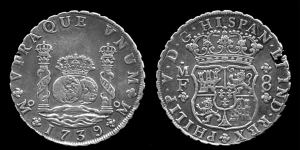
Important Dates in the Monetary History of the United States, Part II: 1776 to 1787 – Independence and Articles of Confederation
By David Liechty
Upon signing of the Declaration of Independence, with the removal of English governmental authority, the independent states asserted plenary power to coin money, issue paper currency, and declare issued paper currency legal tender. The Continental Congress began developing a national system of gold and silver coin based on the Spanish milled dollar in 1776, but as early as 1775 it also issued Continental Currency and other bills of credit. These “Continentals” were ostensibly redeemable in Spanish milled dollars or their equivalent in silver or gold, and the Colonies collectively pledged to redeem them.
The amount issued between 1775 and 1779, approximately $241,500,000, dwarfed the colonial money supply available, which totaled around $10,000,000 in early 1775. This vast over-issuance when compared to potential future tax receipts, hampered by the absence of a national taxing power in the Articles of Confederation (signed in 1777), and combined with uncertainty over the eventual success of the colonies in their war against England, led to pessimism and devaluation. Large-scale counterfeiting of Continentals by the British compounded this loss of confidence and correspondent value.
Whereas in 1777 most states acquiesced in Congress’ request to declare Continentals legal tender at full value, by 1780 none but Massachusetts would accept them for tax payment even at Congress’ lowered fixed rate, then at 1/40th par. Less than a year later Congress devalued the Continentals even further to 1/75th of par value, but finally recommended that they cease to “be current.” Throughout this period, the states continued to issue their own bills of credit and to pass laws declaring these bills legal tender.
Ratification of the Articles of Confederation in 1781, giving Congress the power to regulate coin, both its own and that minted by the states, and the power “to borrow money, or emit bills on the credit of the united states” did nothing to change the situation. The period between 1783 and 1787 was a time of economic chaos. As The Federalist describes, communities developed “[a] rage for paper money, for an abolition of debts, for an equal division of property”, and for “other improper or wicked project[s]” The Federalist No. 10 and here . States continued over-issuing bills of credit, debtors parties gained power and made this depreciated currency legal tender for all debts, and taxpayers’ revolts erupted, including Shay’s Rebellion in 1786.
In 1785, Congress reviewed a plan proposing the Spanish milled dollar as “the Money-Unit” of the United States, and resolved that the “money unit … be one dollar” (29 Journals of the Continental Congress, 1774-1789 (Library of Congress ed. 1904 et seq.) at 499-500 . A Congressional Board of Treasury statement in 1786 indicated that the “dollar” referred to by Congress in 1785 was “the common Dollars that are Current in the United States,” “will contain three hundred and seventy five grains and sixty four hundredths of a Grain of fine Silver,” and “will be worth as much as the New Spanish Dollar,” with relative value between gold and silver coin to be that which “Custom has established” (30 id. at 162-163). By this, Congress reflected the English Common Law system for a national money system as outlined by Blackstone. Congress retained silver and gold as money, established a specific weight of silver as the unit of value against which the value of all other coinage would be regulated, and recognized the propriety of permitting free trade in gold and silver.
David Liechty is an attorney who is currently studying for a Phd in Constitution Studies. He is interning with Solari this summer.

